I realize there a many questions relating to this issue, however i have not found one that solves my issue.
To start, I have set this code in my menu.h
-(BOOL)shouldAutorotateToInterfaceOrientation:(UIInterfaceOrientation)interfaceOrientation {
return YES; }
The status bar changes with orientation but the views are not rotating or resizing. In order to try to narrow down my issue, I decided to try to switch two views within one .xib based on orientation
- (void)viewDidLoad {
[super viewDidLoad];
[[UIDevice currentDevice] beginGeneratingDeviceOrientationNotifications];
[[NSNotificationCenter defaultCenter] addObserver:self selector:@selector(orientationChanged:) name:@"UIDeviceOrientationDidChangeNotification" object:nil];
}
-(void) orientationChanged:(NSNotification *)object
{
UIDeviceOrientation deviceOrientation = [[object object] orientation];
if (deviceOrientation == UIDeviceOrientationLandscapeLeft || deviceOrientation == UIDeviceOrientationLandscapeRight)
{
self.view = self.landscapeView;
}
else
{
self.view = self.portraitView;
}
}
In the iOS simulator, the view definitely changes to the specific views. However the landscape view shows up as if it was portrait and sideways.
my landscape view in IB

My landscape view in the iOS simulator after changing orientation

What am I doing wrong here? I can't figure it out, any help would be greatly appreciated. Thank you in advance. ** EDIT: New Code Below ** Okay.. my issue is that the view loads properly in landscape, it's just sideways. So the Landscape view loads, just sideways. My revised code based on @Seega is:
- (void)viewDidLoad {
[super viewDidLoad];
[[UIDevice currentDevice] beginGeneratingDeviceOrientationNotifications];
[[NSNotificationCenter defaultCenter] addObserver:self selector:@selector(orientationChanged:) name:@"UIDeviceOrientationDidChangeNotification" object:nil];
[[TTNavigator navigator] setCustomTarget:self];
[[TTNavigator navigator] setCustomAction:@selector(photoAction)];
}
- (void)willRotateToInterfaceOrientation:(UIInterfaceOrientation)toInterfaceOrientation duration:(NSTimeInterval)duration
{
if (toInterfaceOrientation == UIDeviceOrientationLandscapeLeft || toInterfaceOrientation == UIDeviceOrientationLandscapeRight)
{
self.view = self.landscapeView;
}
else
{
self.view = self.portraitView;
}
}
-(void) orientationChanged:(NSNotification *)object
{
UIDeviceOrientation deviceOrientation = [[object object] orientation];
if (deviceOrientation == UIDeviceOrientationLandscapeLeft || deviceOrientation == UIDeviceOrientationLandscapeRight)
{
self.view = self.landscapeView;
}
else
{
self.view = self.portraitView;
}
}
